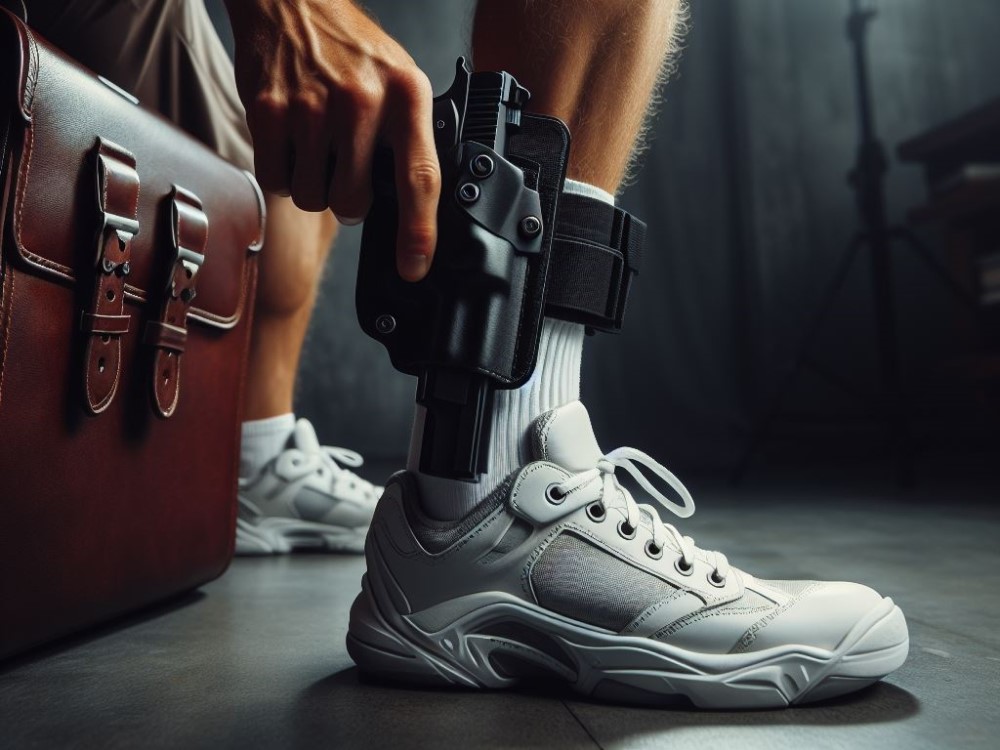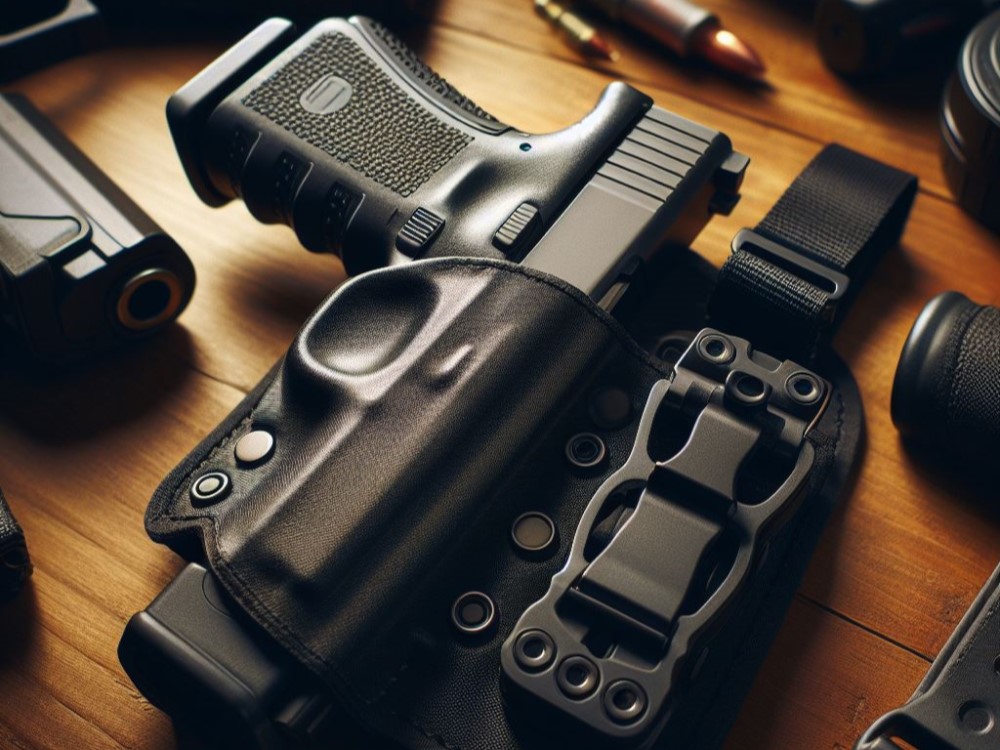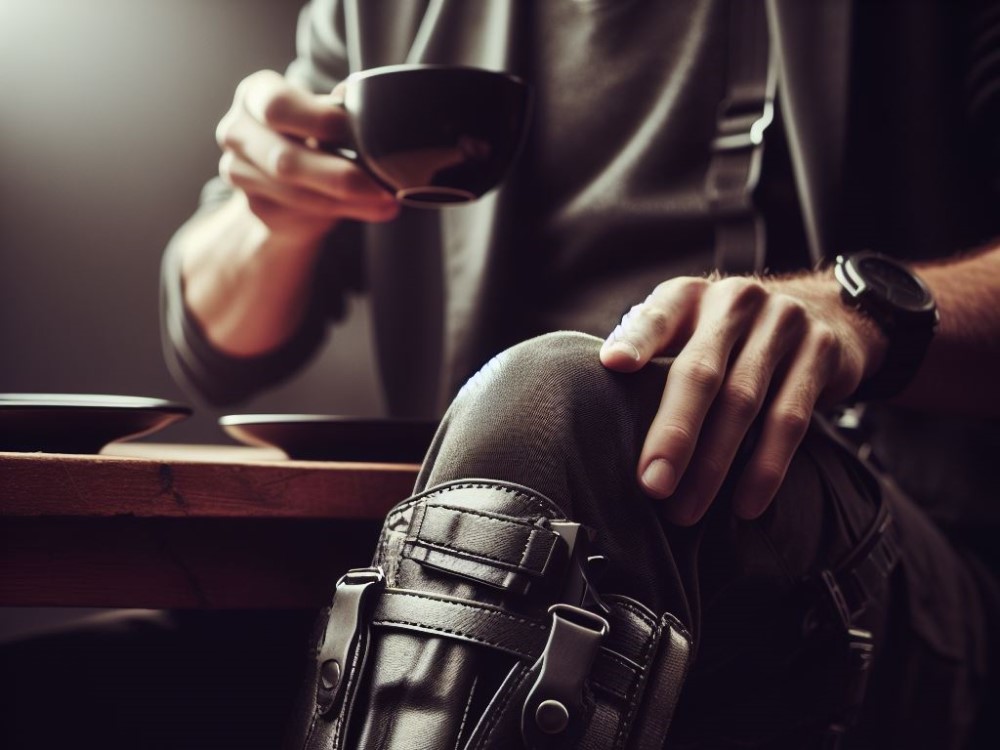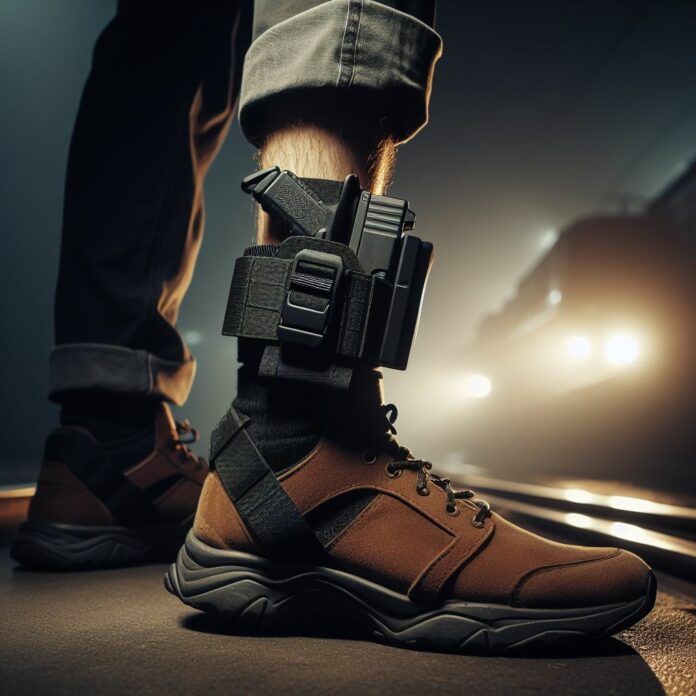Ankle holsters are popular concealed carry options that provide comfort and accessibility for firearm users. If you’re considering wearing an ankle holster, it’s essential to understand the proper usage and techniques. In this article, we will guide you through the process of wearing an ankle holster effectively. But first, let’s introduce ankle holsters and their benefits.
An ankle holster is a specialized holster that securely holds a firearm on the ankle, allowing for discreet and easy access. It is commonly chosen for its concealment, accessibility, and comfort. With an ankle holster, you can keep your firearm hidden while still having quick access to it when needed.
Why choose an ankle holster? Firstly, concealment is a primary reason. Ankle holsters can be easily hidden with the pant leg or under a sock, making it ideal for those who require deep concealment or have clothing restrictions.
Secondly, accessibility is crucial. An ankle holster allows for quick and reliable access to your firearm, especially in situations where drawing from the waistband or other holsters may be impractical.
Lastly, comfort is a significant advantage. Ankle holsters are designed to be comfortable for extended periods, allowing you to carry your firearm throughout the day without discomfort or hindrance.
Now that we’ve covered the benefits, let’s dive into the step-by-step guide on how to wear an ankle holster properly. We will guide you through choosing the right ankle holster, selecting the proper firearm, positioning it on the ankle, adjusting the straps, and testing the fit and comfort. we will provide you with important tips for concealment, draw techniques, and comfort and safety.
By following this comprehensive guide, you’ll be able to wear an ankle holster effectively and confidently, ensuring that you can carry your firearm safely and securely.
What is an Ankle Holster?

An ankle holster is a device used to carry a handgun on the ankle.
It is typically made of a durable material and has straps to secure it in place.
Ankle holsters are commonly used by law enforcement officers and concealed carry permit holders who want an alternative method of carrying their firearm.
They provide a discreet and easily accessible way to carry a weapon.
Ankle holsters are designed to fit snugly around the ankle, allowing for quick and easy access to the handgun when needed.
They offer a convenient and comfortable way to carry a firearm, especially when other methods of carrying may not be suitable.
Ankle holsters are particularly useful for individuals who spend a lot of time sitting or need to have their hands free while carrying a weapon.
Why Choose an Ankle Holster?
When it comes to choosing the right holster, the ankle holster is a top contender. Wondering why? Well, in this section, we’ll uncover the reasons that make the ankle holster a popular choice among gun owners.
From its superior concealment capabilities to its quick and easy accessibility, and not to mention the comfort factor, we’ll dive into why the ankle holster ticks all the right boxes.
So, whether you’re a seasoned gun enthusiast or someone new to carrying concealed, you’ll want to know what this section has in store for you. Get ready for some ankle holster insights!
1. Concealment
- Ankle holsters offer excellent concealment for carrying firearms.
- The compact size and positioning on the ankle make it easy to hide the firearm under clothing.
- Concealment is crucial for situations where open carry is not permitted or when maintaining a low profile is necessary.
- With an ankle holster, you can discreetly carry your firearm without drawing attention.
- It allows you to easily blend into your surroundings, whether you’re in a crowded area or going about your daily activities.
- Ankle holsters provide a tactical advantage in situations where surprise is key.
- They allow for a quick and inconspicuous draw, catching opponents off guard.
- By keeping the firearm on the ankle, you can keep your hands free for other tasks, increasing accessibility.
- Law enforcement officers, security personnel, and individuals practicing concealed carry can benefit from the concealment offered by an ankle holster.
2. Accessibility
One of the main benefits of using an ankle holster is its accessibility.
By securely attaching the holster to your ankle, you can easily access and draw your firearm when necessary.
This accessibility is particularly advantageous in situations where quick weapon retrieval is crucial, such as self-defense scenarios.
Moreover, the ankle placement of the holster enables a discreet and inconspicuous draw, as the gun remains concealed under your pant leg.
3. Comfort
Ankle holsters prioritize comfort for the wearer.
The comfort of the wearer is a top priority when it comes to ankle holsters.
The holster should be made from high-quality materials that feel comfortable against the skin.
One important aspect of ankle holsters is the level of comfort they provide for the wearer.
It should have padding or cushioning to prevent discomfort or irritation during prolonged wear.
Ensuring the wearer’s comfort, ankle holsters should incorporate padding or cushioning to prevent discomfort or irritation.
The adjustable straps should be designed to distribute the weight evenly and prevent the holster from digging into the ankle.
In order to enhance comfort and prevent any discomfort, the ankle holster’s adjustable straps should be carefully designed to distribute weight evenly.
Step-by-Step Guide: How to Wear an Ankle Holster?

Looking to learn how to wear an ankle holster? Look no further! We’ve got you covered with a step-by-step guide that will walk you through the entire process.
From choosing the right ankle holster to selecting the proper firearm, positioning on the ankle, adjusting the straps, and testing the fit and comfort, each sub-section will provide valuable tips to ensure a secure and comfortable fit for your ankle holster.
So, let’s dive right in and get you equipped with all the necessary know-how!
Step 1: Choose the Right Ankle Holster
In order to ensure a comfortable and effective carry, the first step is to choose the right ankle holster. Here are the steps to follow:
- Consider the size and weight of your firearm. Make sure that the ankle holster you select can adequately support and conceal your specific firearm.
- Look for a holster that offers adjustable straps. This will enable you to customize the fit and ensure a secure and comfortable carry.
- Select a holster made from high-quality materials. Seek out options that are durable, moisture-wicking, and have reinforced stitching to ensure longevity.
- Take the draw angle into account. Find a holster that offers an adjustable cant to accommodate your preferred draw angle.
- Consider your personal preferences and needs. If you prefer a holster with additional features such as extra magazine pouches or retention straps, take this into consideration during the decision-making process.
By following these steps, you will be able to choose the right ankle holster that meets all of your specific requirements, ensuring a secure and comfortable carry.
Step 2: Select the Proper Firearm
Consider the purpose of the firearm. Determine whether you need a firearm for self-defense, target shooting, or hunting. Each purpose may require a different type of firearm.
Assess your experience and skill level with firearms. If you are a beginner, opt for a firearm that is easier to handle and operate. As you gain more experience, you can consider more advanced options.
Research and understand the different types of firearms available. This includes handguns, rifles, and shotguns. Each type has its own features and uses.
Evaluate the size and weight of the firearm. Consider factors such as your body size and how comfortable you feel carrying the firearm on your ankle. Ensure that the firearm is not too bulky or heavy for your intended use.
Consider the caliber and ammunition capacity of the firearm. Choose a caliber that matches your intended use, whether it’s for self-defense or target shooting. Additionally, consider how many rounds the firearm can hold and how easy it is to reload.
Visit a reputable firearm dealer or shooting range to handle different firearms and seek expert advice. Test-fire various firearms if possible to determine which one feels most comfortable and suits your needs.
Research local laws and regulations regarding firearm ownership and concealed carry. Ensure that the firearm you choose complies with all legal requirements in your area.
Take into account your budget. Firearms can vary greatly in price, so determine how much you are willing to spend and find a firearm that offers a balance of quality and affordability.
Consider the availability of accessories and aftermarket support for the chosen firearm. This includes holsters, magazines, and sights. Having a wide range of compatible accessories can enhance your overall experience with the firearm.
Step 3: Positioning on the Ankle
Positioning the ankle holster correctly is a crucial step in ensuring comfort, accessibility, and concealment.
Follow these steps to position the holster on your ankle:
- Choose the right ankle holster: Select an ankle holster that is specifically designed for your firearm and offers secure retention.
- Select the proper firearm: Ensure your firearm is suitable for ankle carry, considering factors like size, weight, and barrel length.
- Place the holster on the inside of your ankle: Position the holster on the inside of your non-dominant ankle, where it can be easily accessed with your dominant hand.
- Align the holster with the centerline of your leg: Adjust the holster so that it aligns with the centerline of your leg for better balance and stability.
- Secure the holster with straps: Adjust the straps according to your comfort level, ensuring the holster is snugly fit without restricting circulation.
- Test the fit and comfort: Walk around and perform movements to test the fit and comfort of the ankle holster. Make adjustments if necessary.
Proper positioning of the ankle holster is essential for optimal performance when carrying concealed. Follow these steps to ensure a secure and comfortable fit.
Step 4: Adjusting the Straps
Adjusting the straps is an important part of wearing an ankle holster correctly.
- First, loosen the straps: Before putting on the ankle holster, make sure to loosen the straps for a comfortable fit.
- Next, slide the holster into position: Place the holster on the inside of your ankle, positioning it in a way that is both comfortable and allows for easy access to your firearm.
- Now, tighten the straps: Once the holster is in the proper position, securely tighten the straps. It is crucial to ensure that the holster is snug against your ankle to prevent any movement or shifting.
- Adjust for comfort: Check that the straps are not too tight, as this can cause discomfort and restrict blood flow. Adjust them until you find the right balance between security and comfort.
Pro-tip: It’s important to regularly check the straps throughout the day while wearing an ankle holster. As you move and engage in different activities, the straps may loosen slightly.
Taking a moment to readjust them will help ensure the holster stays securely in place.
Step 5: Testing the Fit and Comfort
When testing the fit and comfort of an ankle holster, follow these steps:
- Put on the ankle holster and secure it in place.
- Ensure that the holster fits snugly around your ankle without feeling too tight or restricting your movement.
- Walk around to test the comfort and stability of the holster. Make sure it doesn’t shift or slide down your leg while walking.
- Bend your knee and perform a few squats to check if the holster stays in place and doesn’t dig into your leg.
- Testing the Fit and Comfort, try sitting down and standing up to see if the holster remains comfortable and doesn’t cause any discomfort or irritation.
To enhance the fit and comfort of your ankle holster, consider the following suggestions:
- Wear thick or padded socks to help improve the comfort and minimize any rubbing or irritation.
- Choose an ankle holster with adjustable straps or a Velcro closure, allowing you to customize the fit according to your leg size.
- Regularly check the condition of your ankle holster and replace it if it becomes worn out or loses its shape.
By testing the fit and comfort of your ankle holster and making the necessary adjustments, you can ensure a secure and comfortable carrying experience.
Tips for Wearing an Ankle Holster

Looking to wear an ankle holster? Check out these valuable tips for maximizing concealment, perfecting draw techniques, and ensuring comfort and safety. With these insider suggestions up your sleeve, you’ll be ready to rock your ankle holster with confidence.
No more fumbling or discomfort – we’ve got you covered! Keep reading to discover the tricks of the trade that will take your ankle holster game to the next level.
Tips for Concealment
When looking for an ankle holster, make sure to choose the right size that fits snugly around your ankle for optimal concealment under your clothing.
To help conceal the ankle holster, consider selecting clothing options such as pants with a looser fit or longer shirt lengths.
For better concealment, position the ankle holster on the inside of your ankle to minimize printing and keep it hidden.
In order to further hide the ankle holster, wear dark-colored socks that match your pants.
Be mindful of your posture at all times to avoid unintentionally revealing the ankle holster when sitting, bending, or walking.
Pro-tip: Practice various movements and positions while wearing the ankle holster to ensure it remains properly concealed in different situations.
Tips for Draw Techniques
When it comes to draw techniques for wearing an ankle holster, there are several tips for draw techniques to keep in mind:
- Practice regularly: Consistent practice is essential to improve your draw speed and accuracy. Set aside time for dry-fire drills and live-fire practice sessions to enhance your skills.
- Maintain a proper grip: To ensure a secure and efficient draw, grip the firearm firmly with your dominant hand, placing your finger alongside the frame of the gun until you are ready to shoot.
- Master the draw motion: Develop a smooth and fluid draw motion by practicing the sequence of withdrawing the firearm from the ankle holster, bringing it up to the shooting position, and getting your sights on target.
- Practice under different conditions: To be prepared for various situations, practice drawing your firearm from the ankle holster while sitting, standing, or kneeling. This will help you become proficient in different scenarios.
- Minimize unnecessary movements: Aim to eliminate any unnecessary or excessive movements during the draw. Efficiency and speed are vital in self-defense situations, so focus on keeping your technique streamlined.
By following these tips for draw techniques, you can enhance your skills and readiness when wearing an ankle holster.
True story: John, a seasoned law enforcement officer, used an ankle holster for his backup firearm. Through rigorous training and implementing proper draw techniques, John was able to swiftly draw his weapon from the ankle holster during a high-pressure situation. His accuracy and quick response played a crucial role in ensuring the safety of himself and others.
Tips for Comfort and Safety
Choose the right size: To ensure comfort and unrestricted movement, it is important to select an ankle holster that fits snugly around your ankle.
Position it correctly: For optimal comfort and easy access, place the ankle holster on the inside of your non-dominant leg.
Adjust the straps: Take the time to adjust the straps of the ankle holster to achieve a secure and comfortable fit. This way, it won’t slide or shift during your movements.
Wear comfortable socks: Enhance comfort and prevent friction-induced irritation by wearing moisture-wicking and breathable socks.
Practice drawing techniques: Familiarize yourself with the process of drawing your firearm from the ankle holster by practicing regularly. This way, you can react quickly and efficiently in high-stress situations.
Regular maintenance: Keep your ankle holster clean and free from debris that may cause discomfort or interfere with the smooth draw of your firearm.
Frequently Asked Questions
How to wear an ankle holster?
Wearing an ankle holster correctly is essential for comfort, accessibility, and concealment. Here are some steps to follow:
- Select a suitable ankle holster that securely and comfortably fits your gun. Consider factors such as specific gun compatibility, padding, and retention straps.
- Decide whether you prefer wearing the ankle holster on the inside or outside of your ankle. This choice depends on personal preference and clothing style.
- Wear tactical pants or trousers cut longer and wider, such as bootcut pants, to properly conceal the ankle holster and prevent printing.
- Consider wearing compression socks, especially when engaging in activities like running. Compression socks provide support and increase comfort while wearing the ankle holster.
- For optimal comfort and concealment, match your ankle holster with tall boots and socks. This combination helps in reducing any discomfort and increasing concealment.
- Ensure you are mindful of leg crossing and sitting positions to prevent inadvertent exposure of the ankle holster.
What are the benefits of ankle carry?
Ankle carry offers several advantages as a concealed carry method. These benefits include:
- Having a backup gun readily accessible in case the primary gun malfunctions or is disarmed.
- Easy concealment in dress code-restricted environments where traditional holsters are not feasible.
- Convenient access to the firearm, especially in seated positions or when driving a car.
- The ability to hold a spare magazine in the ankle holster, providing added ammunition.
Is ankle carry suitable for everyone?
Ankle carry may not be suitable for everyone. Consider the following factors before deciding:
- Assess your physical abilities and limitations to safely access the gun and holster from the ankle.
- Evaluate your comfort carrying both primary and secondary firearms.
- Take into account the size and weight of your firearm, as larger guns can be more challenging to conceal on the ankle.
What are some considerations when choosing an ankle holster?
When selecting an ankle holster, there are various factors to consider:
- Ensure the ankle holster is specific to your gun, providing a secure fit and proper retention.
- Look for padding and retention straps in the ankle holster for added comfort and secure retention of the firearm.
- Consider if a calf gun holster is necessary for additional support and comfort.
- Read online reviews to gather feedback from other customers and choose a reputable and reliable ankle holster.
How do I draw a firearm from an ankle holster?
Drawing from an ankle holster requires practice to ensure a fast and accurate draw. Here are some tips:
- If seated, drawing from an ankle holster is relatively easier. Practice acquiring the gun using both hands and bringing it into a ready position.
- If standing, drop back on your dominant leg and bend from the waist to raise the pant leg and acquire the gun from the ankle holster.
- Throughout the drawing process, keep your head up and focus on the potential threat.
- Regularly practice drawing from different positions, such as standing and seated, to improve proficiency.
What are the drawbacks of ankle carry?
While ankle carry can be a practical option, it has some drawbacks to consider:
- Ankle holsters tend to attract dirt and dust, which can cause malfunctions. Establish a cleaning routine to keep the holster and firearm clean.
- Drawing a firearm from an ankle holster can be more difficult compared to other carry methods, especially in a standing position.
- Improper concealment or adjustments may lead to unintentional exposure of the weapon.
- Ankle carry may take more time to draw, requiring practice to ensure a fast and accurate response in critical situations.

